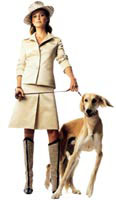Sloane square turns chic
Classic British brands are trying to follow Burberry’s lead and inject some new life into their products. Hannah Booth asks how design can help these companies revitalise their image

Mackintosh has joined the legion of traditional British brands trying to shake off their stuffy, wellies-and-waxed-jacket images to reinvent themselves as contemporary, design-led marques. It is opening a London flagship this year and expanding into furniture design.
Where Burberry led the way with branded bandanas and dog bowls, Pringle and Mulberry have followed (DW 23 February). Austin Reed, Hackett and Mackintosh are also joining the ranks, with standalone stores and expanded product ranges. And design is being increasingly integrated into the process.
Pringle, home of the sports casual look perfected by spoof DJ Alan Partridge, is in the middle of a major brand repositioning exercise. Since its takeover by Hong Kong textile group Fang Brothers in March 2000 and the appointment of Kim Winser as chief executive, it has sought to transform its fuddy-duddy image.
It is opening its first UK standalone store in central London (DW 23 February), scheduled to open this autumn. FutureBrand is a front-runner for creating interiors for the store, based on concessions it has designed for the brand in Selfridges and Oxford Street’s DH Evans.
FutureBrand created the interiors for Pringle’s trade showroom in London’s Grafton Street, which opened last October, and redesigned Pringle’s lion corporate identity last year (DW 27 October 2000).
“Modernising the Pringle lion was our first task,” says FutureBrand creative director Mark Staton. “We wanted to distance the brand from its golfing and Nick Faldo associations and complement the new direction of the clothing and advertising. The trade showroom is subtle and contemporary, with a Scottish hint.”
Pringle is repositioning itself as a contemporary, high-fashion brand, building on the heritage of its lion and Argyle icons, says marketing and sales director Martin Mason. It has introduced a diffusion clothing range, Pringle Sport, and is launching a casualwear collection this year, likely to grace the backs of fans such as David Beckham and Jamie Oliver.
“Pringle is cool,” says Mason. “We are capitalising on the demand for British fashion and, in particular, companies with a strong heritage. Britishness is associated with quality of manufacturing and any brand transformation must be product-driven.”
Its strategy is working. Sales at Pringle are up 30 per cent and it has just made its first showing at London Fashion Week.
Upmarket outerwear manufacturer Mackintosh is hoping for similar success. It is launching its first standalone store in late 2001 in London to build the Mackintosh brand, which currently accounts for around 70 per cent of the company’s sales.
It will be approaching design consultancies later this year to create interiors for its flagship store and is expanding into branded accessories such as luggage and furniture.
The opening of its first dedicated store should drive the brand’s expansion into key markets in Asia and the US, says Mackintosh managing director Daniel Dunko.
“We have a highly niche market at present, but aim to become a major luxury brand for the future, competing with Hermès and Louis Vuitton,” says Dunko. “The climate is right for British brands.”
Traditional clothing brand Daks Simpson is also getting in on the act. Timothy Everest joined as creative director last month to inject some pizzazz into the brand and hopes to expand in Europe with flagship stores in Paris and Milan next year. Dunko says it is too early to start thinking about design work.
Created in 1934 from a combination of the words “dad” and “slacks”, the Daks brand introduced its trademark Margot Leadbetter checks in 1976. It opened a flagship store last September in London’s Old Bond Street, with interiors designed in-house by Peter Southgate.
Austin Reed, which is introducing its more contemporary AR logo to its concessions and standalones following a brand review by the then Interbrand Newell and Sorrell in 1997, is seeking to treble its UK concessions. And Hackett is planning to open around 40 dedicated stores worldwide.
But it’s not just clothing brands capitalising on the new-found penchant for traditional British brands and sensible tweeds. Established crystal glass manufacturer Dartington appointed design director Simon Moore in October to give the brand fresh direction. Moore sees design as the key to reaching new audiences. He is establishing an in-house team of designers and a pool of freelances to shake up the brand, and has just launched his first two glass collections.
Last month’s relaunch of the Dartington Studio range features strong colour and texture to appeal to younger consumers and grow its important export market.
“I was brought in to gently elevate the Dartington Crystal brand without outpricing existing customers,” says Moore. “Its heritage is vital, in vogue, and will help us expand abroad without holding us back in the UK. Customers are more educated about design than ever and look for subtle details.”
Wedgwood has adopted a similar approach. The 250-year-old company is moving into furniture design and production for the first time (DW 23 February).
Three years ago it decided to shake off its “blue and white” image and reposition itself as a contemporary, luxury brand without losing its quintessential “Englishness”. It employed The Partners to create a brand identity, and has since worked with product
designers including Nick Munro and Michael Sodeau.
The sudden popularity of twinset-and-pearls British brands is due to the arrogance of companies that have sat on their brands for too long, says M&K Design chairman Paul King, who created in-store concepts for retailers such as Laura Ashley.
Only now are they realising that a mix of strong heritage, skillful use of design and marketing can create great results.
“Companies must accept that markets change and retail, in particular, does not stand still for long,” says King. “The current ‘floral dress revival’ and fondness for British brands should be capitalised on – but to stop listening to customers is dangerous.”
-
Post a comment




